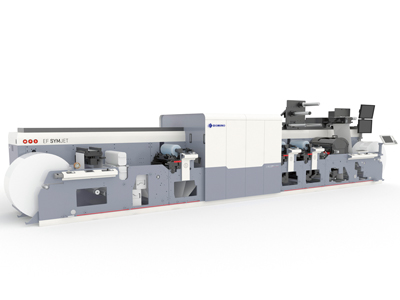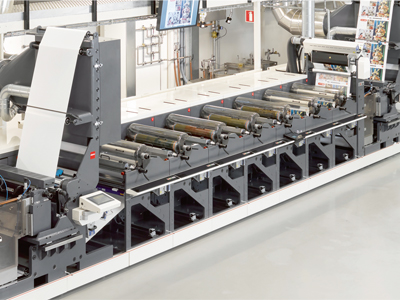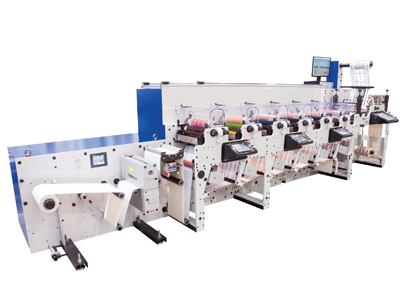The Proflex SE enables easy loading of ink cartridges and print cylinders
Despite most label press manufacturers saving product launches for Labelexpo Americas in the autumn of this year there is still plenty to talk about in the label sector as manufactures aim to tackle the current needs of the market. By Michal Lodej.
The labels market has experienced many of the same changes as other printing sectors with the trend of shortening run lengths and customers’ desire for ecological credentials growing.
To react to these needs, press manufacturers have made an effort to focus on reducing change over times, as job changes appear more frequently with the current trend of short run work. With this, waste reduction methods come hand in hand, the faster a press is producing saleable labels, the less waste is produced.
Other factors have also played an important part in recent changes to press technology. Manufacturers want to make their machines flexible in terms of the types of substrates they can use and as always they must be user friendly.
Making it easy
UK-based Focus Label Machinery was one of the few label press manufacturers to show new products at drupa, which included its new generation of the Proflex compact flexo press.
The Proflex SE (servo drive)/Proflex E (lineshaft drive), is a modular press available with print widths of 250 mm and 330 mm. Several different drying systems are available, including full UV, LED, Infra-Red or combination drying systems, with optional chill rolls for heat sensitive substrates.
The open architecture design of the print stations enables easy loading of ink cartridges and print cylinders, whilst interchangeable print cartridges can be partially or fully unloaded and exchanged, in order to maximise productivity and minimise downtime. Bearer rings are incorporated into the print cylinder assembly, to guarantee accurate print impression settings, regardless of substrate.
Print cartridge assemblies can be cleaned off press, allowing the operator to maintain uninterrupted production. As well as flexo print stations, there is also a facility to accommodate a full colour or single colour digital inkjet system, for short run and variable data requirements.
Both models benefit from touch screen HMI operator interface panels, for all press control functions, plus storage of job information for future reference. The SE model has additional servo assisted control for all press operations and fully programmable digital platforms. The new features have decreased set up time and material wastage, resulting in reduced downtime and higher productivity. The operator can control all aspects of press operation, from any of the HMI touch screen control panels and can store job information for future retrieval on repeat orders. Print modules incorporate Digital Drive technology, reducing mechanical register errors and providing greater control over a wide range of substrates.
Optional automatic print register control can easily be integrated into the servo press, to assist with print registration on difficult substrates. Also, the modular design of the system means that future addition of extra print heads and other optional equipment is easily facilitated.
In addition, a rail system can be mounted along the top of the press, to allow optional overhead press equipment to be easily transported to the required position. Options such as turn-bar, delam-relam, cold foil, laminating, waste rewind turret, scanner systems, can all be rail-mounted.
Observing the emerging trend for greater automation Edale developed AIIR, a fully automated inking, print impression and camera controlled liner with cross registration. The company has teamed up with press control system specialist AVT to integrate its camera-based technology into the Edale range of FL3 and FL5 flexographic presses. Bespoke software developed in-house ensures that five additional motors, individually positioned on each print station adjust the print impression, inking and cross register to ensure the highest print quality.
Registration marks are printed on each station and fed through to the AVT Helios S camera positioned at the end of the press. The camera analyses the relative positions of the marks and sends necessary corrections to the respective print stations. Sophisticated tracking software ensures that no additional corrections are made until the initial corrections have passed the camera.
To minimise waste, the AVT Helios S camera is designed to complement the press’ pre-register and print-to-mark register systems, ensuring that a saleable product can be achieved in no more than two web lengths of the machine. Increased linear and cross-registration accuracy can be maintained throughout the print run, without the intervention of operators manually adjusting registration settings which can lead to increased wastage and out of register prints.
The technology reduces the number of operator inputs and time needed to set up a job by automatically positioning the pressure settings based on saved job data or material calliper. Print consistency is enhanced through operator defined profiles that adjust pressure relative to press speed.
Best of both
With the recent introduction of hybrid presses to the market, Edale formed a partnership with FFEI to integrate its digital print engine onto its web transportation system comprising of flexographic print stations and inline finishing modules. This partnership created the Graphium, a press that combines workflow, digital and flexographic print with automated finishing, for short, medium and long run labels, packaging and cartons. This allows customers to choose a significantly wider range of solutions for their printing requirements.
Edale has developed a number of partnerships with OEMs so that technology such as automated label finishing, which is widely used in digital label finishing, is now available on its own presses. This technology serves to reduce setup times and waste whilst reducing tooling cost and reliance on the operator. Furthermore, the reduction in tool handling helps to create a safer working environment.
Working in partnership with ABG International allowed the company to integrate semi-rotary technology into the Graphium and FL3. The Hybrid Rotary & Semi-Rotary Die Cutting is a system in which a single die cassette operates in full rotary for high speed converting and semi-rotary mode for quick change providing ultimate flexibility for the converter. In semi-rotary mode the automatic die load/unload reduces operator input whilst increasing the accuracy of die plate mounting. The cut position is automatically pre-registered to the print eliminating waste. Semi-rotary technology eliminates the need to change magnetic cylinders, further reducing setup times making converting smarter and safer.
Alongside this the Break Free waste rewind system combines both conventional and contact waste stripping technologies. This flexible approach increases productivity when stripping more complex shapes. Finally, AutoSlit fully automates the setting of the sheer slitting and back scoring by positioning the blades based on pre-programmed positions. A higher level of accuracy can be achieved first time whilst significantly reducing setup time and reliance on operator skill.

MPS’ hybrid press, the EF Symjet, combines digital with flexo
MPS also introduced a hybrid printing press working in partnership with Domino. The press combines flexo and digital to schedule print in the most efficient way possible, however, several factors can influence the best effort to achieve the highest possible efficiency.
Bert van den Brink, MPS technical director said, ‘We have created a highly flexible machine that will allow converters to combine flexo and digital printing, or use separately inline, as well as converting in one-pass. This solution fills the gap between conventional flexo and digital printing machines.’
The digital Domino has a 333 mm maximum print width, while the MPS EF multi-substrate press is wider at 430 mm. This gives converters the option to run more labels across, when operating in pure flexo mode, and at higher speed.
Designed for label and flexible packaging printing from thin unsupported film to thick carton board, the press offers a wide range of converting options, including multi-layer label production, die-cutting and lamination. As customer demands are for shorter runs with greater variation, the new hybrid EF Symjet provides an alternative option that is both flexible and productive.
With the EF Symjet, print jobs can run all flexo, with the Domino serving as a pass-through, all digital, with the MPS EF serving as the material handling and finishing, or a combination of the two working together in hybrid mode. The press also adds a wide range of inline converting solutions, from automatic quick change die cutting and embossing solutions, to flexible positioning rail unit solutions for lamination, cold foil, hot foil and de-lam/re-lam.
Staying agile
The new FA-6* is Nilpeter’s response to the need for a flexible press that handles multiple substrates. As the global flexible packaging market is growing, 3.5% year-on-year until 2020 according to Smithers Pira, the company wanted to offer a press which gave high quality, cost-effective and multi-substrate printing.

Nilpeter’s FA-6* is capable of running a wide range of substrates
Increasing volumes of shorter run jobs now drive the fast-growing global flexible packaging market. At the same time, brand owners prefer single suppliers for all, or most, of their packaging needs, while demanding more from them.
The press features a control panel with individual job change functionalities, and it can be combined with the Nilpeter multi-purpose units, MP-6, designed as a quick-change platform featuring multiple high intensity air drying and UV-curing systems of process work, inks, adhesives and coatings.
An innovative sleeve system permits an extra-short web path, with easy loading of tooling, and the Nilpeter CleanInking system combined with the Nilpeter PowerLink control system helps printers achieve a lean production.
Inline functions, when integrating the MP-6, include high-speed solvent and water-based flexo printing with a reverse-side capability. A UV-cured lamination capability includes glossy effects, surface protection, barrier solutions and cold foiling. There is also a solvent dry lamination capability for special laminates, barriers, pouches, and sachets.
Other value-adding options include the G-6 gravure unit. Using cassettes, it prints metallic inks, opaque white and special coatings, which increase the decorative options for flexible packaging. Reversible ink-heads allow front or reverse-side printing. G-6 units have adjustable doctor blades, an ink circulation system, viscosity control and a drying and vacuum system for use with solvent-based products.
The Nilpeter FA-6* has a maximum print width of 560 mm its innovative sleeve system permits an extra-short web path with easy loading of tooling to reduce substrate wastage. The repeat length is 304.8-635 mm for flexo and 457.2-635 mm for die-cutting. The press has a top mechanical speed of 175 m/min.
Alternative presses
Traditionally, label presses are narrow web machines built in an inline printing configuration, however there are exceptions to the rule.
Soma’s Optima press was the only CI press to be shown at the Labelexpo Europe 2015, the press is aimed at bridging the gap between narrow and wide web printing and can run with products such as in-mold and wrap around labels, shrink sleeves, retort pouches and sachets as well as paper sacks, cups and plates.
Available in 620 and 820 mm widths in up to eight colours, the press is capable of speeds up to 300 m/min and features unwind and rewind systems that are located outside the printing unit modules. This variable design allows the option of choosing any unwind/rewind configuration and in-line upstream or downstream printing and converting units such as cold seal or slitting.
Another CI press, which has caught the eye of some label printers, is Expert’s Compact press. The press is developed for short runs with a web width ranging between 600 and 1000 mm. The machine’s print repeat ranges from 240 to 650 mm and it can run at up to 300 m/min.
At drupa 2016 Renato Giovannini, Expert’s sales and marketing director toldFlexoTech, ‘We have had a lot of interest from label printers because of its small footprint. And when you compare the web width, 600 mm isn’t too far away from some of the narrow web label presses built today.’
At the time of writing this article there was also a known-unknown on the horizon from Gallus. The company is set to launch a new label press at its Innovation Days event in September 2016 its headquarters in St. Gallen, Switzerland.
The company will present the first pre-series model of a new machine generation: a conventional label printing machine, equipped with flexo-printing units, that is designed for the label and packaging market. According to the company the machine has a new platform construction and can be configured to meet customer’s requirements for the level of automation or the web width.






